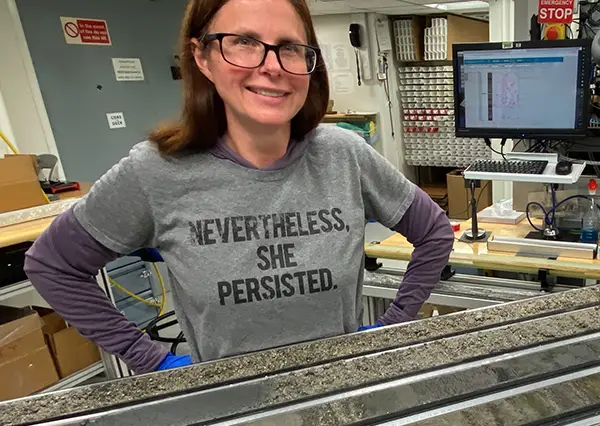McCanta Explores Volcanic History with an Eye to the Future
News

McCanta Explores Volcanic History with an Eye to the Future
Volcanoes seem to make frequent headlines in recent years. Hunga-Tonga Hunga Ha’apai, in Tonga, erupted in a massive explosion in 2022. Hawaii’s Kilauea sent rivers of lava flowing multiple times throughout 2023. This year, the southern Icelandic town of Grindavik is under threat from an ongoing series of eruptions.
Molly McCanta, associate professor in the UT Department of Earth and Planetary Sciences, joined colleagues on International Ocean Discovery Program (IODP) Expedition 398 last year to study the Hellenic Arc Volcanic Field—looking for information from ancient events that could inform expectations for modern eruptions.
The team discovered evidence that sheds new light on an ancient eruption from under the Aegean Sea. Their findings, published in Nature Communications Earth & Environment in January 2024, introduce the Archaeos Tuff, a giant pumice deposit around the Greek island of Santorini.
“With the Archaeos Tuff, we have identified a piece of Santorini’s earliest history that was significantly more violent than we previously knew,” said McCanta, who served as the geochemistry lab lead for the expedition.
This event occurred around 520,000 years ago, so no large eruptions are anticipated at Santorini anytime in the near future. But the findings provide a more comprehensive picture of eruptive cycles so that hazard assessments can be as detailed as possible.
“Following the large unexpected eruption in January 2022 of Hunga Tonga-Hunga Ha’apai, a new appreciation for these underwater eruptions was produced,” said McCanta. “From our data, it appears the Archaeos Tuff was produced in such an eruption, although much larger than this recent one in the South Pacific.”
Expedition 398 researchers collected deep-sea drillcores from the ocean floor to build their record of the Archaeos Tuff.
“My duties in the geochemistry lab included taking samples of the volcanic tephra layers we encountered and completing chemical characterization using the shipboard ICP-OES (inductively coupled plasma–optical emission spectroscopy),” said McCanta. “This chemical characterization was one of the first hints we got that the deposit was as large and extensive as we now know.”
A large part of McCanta’s research is based around understanding the effects of water and oxidation conditions on magmas and eruption dynamics.
“I am especially interested in subduction zones, like in Greece or the Cascades of the western USA,” she said. “In these regions, a tectonic plate is being thrust beneath another plate. As the downgoing plate is subducted, fluids released from the plate migrate upwards and generate melting in the overlying mantle. These melts, which often have high H2O contents, lead to explosive volcanic eruptions above the downgoing plate.”
A large number of these types of eruptions occurred in the Aegean over the last thousands and millions of years. Deep-sea drilling is the only way to access evidence of these, as material on land is often eroded away. The JOIDES Resolution, the ship used in the expedition, is one of the few science-dedicated vessels available to researchers to study this underwater record of history.
“Therefore, I was particularly excited to join Expedition 398 as a way to better understand subduction processes in this region,” said McCanta. “The effort following the expedition is ongoing. There are currently multiple manuscripts in progress and the data and rocks collected will be available to scientists in perpetuity to study and analyze.”
On the UT campus, multiple undergraduate and graduate students engage with McCanta’s continued research, studying samples using a variety of methods to tell myriad stories of volcanic history—and learn more about the volcanic present.
“I have a current graduate student using visible-near infrared spectroscopy to search for cryptotephra layers in several meters of drillcore to identify small eruptions,” said McCanta. “Which may not be as exciting as huge eruptions like that that produced the Archaeos, but are more frequent and worrisome to populations.”